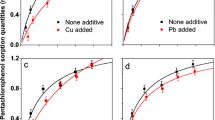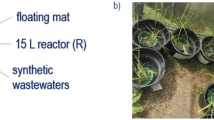Abstract
The presence of nanoparticles (NPs) in natural aquatic environment is a potential risk to aquatic and human life. Periphyton, ubiquitous in aquatic environment, has been used to remove pollutants from aquatic systems. Understanding the interaction between NPs and periphyton will help to better predict the behavior and fate of NPs in aquatic media. This study was aimed to investigate the CuO NP biosorption mechanism by periphyton at acidic, neutral, and alkaline pH and with varying natural organic matter (NOM) concentrations. The rate of adsorption and removal of CuO NPs was decreased with increase in initial pH and NOM concentration. The zeta potential study suggests that the biosorption of CuO NPs by periphyton was related to electrostatic force of attraction. The particle size distribution of CuO NPs in solution with different NOM concentrations played an important role in CuO NP removal. The well fit between pseudo-first-order kinetics and adsorption process indicated that physical sorption appears to be the dominating process. These results show that periphyton can be employed for an environmentally benign and effective solution for NP removal.







Similar content being viewed by others
References
Adam N, Schmitt C, Galceran J, Companys E, Vakurov A, Wallace R, Blust R (2014) The chronic toxicity of ZnO nanoparticles and ZnCl2 to Daphnia magna and the use of different methods to assess nanoparticle aggregation and dissolution. Nanotoxicology 8(7):709–717
APHA, AWWA and WEF (1998) Standard methods for the examination of water and wastewater. American Public Health Association/American Water Works Association/Water Environment Federation, Washington, DC
Aruoja V, Dubourguier HC, Kasemets K, Kahru A (2009) Toxicity of nanoparticles of CuO, ZnO and TiO2 to microalgae Pseudokirchneriella subcapitata. Sci Total Environ 407(4):1461–1468
Battin TJ, Kammer FV, Weilhartner A, Ottofuelling S, Hofmann T (2009) Nanostructured TiO2: transport behavior and effects on aquatic microbial communities under environmental conditions. Environ Sci Technol 43(21):8098–8104
Fabrega J, Fawcett SR, Renshaw JC, Lead JR (2009) Silver nanoparticle impact on bacterial growth: effect of pH, concentration, and organic matter. Environ Sci Technol 43(19):7285–7290
Flemming HC, Wingender J (2010) The biofilm matrix. Nat Rev Microbiol 8(9):623–633
Gao J, Powers K, Wang Y, Zhou H, Roberts SM, Moudgil BM, Barber DS (2012) Influence of Suwannee River humic acid on particle properties and toxicity of silver nanoparticles. Chemosphere 89(1):96–101
Gottschalk F, Sonderer T, Scholz RW, Nowack B (2009) Modeled environmental concentrations of engineered nanomaterials (TiO2, ZnO, Ag, CNT, fullerenes) for different regions. Environ Sci Technol 43:9216–9222
Hou J, Miao LZ, Wang C, Wang PF, Ao YH, Qian J, Dai SS (2014) Inhibitory effects of ZnO nanoparticles on aerobic wastewater biofilms from oxygen concentration profiles determined by microelectrodes. J Hazard Mater 276:164–170
Jing H, Mezgebe B, Aly Hassan A, Sahle-Demessie E, Sorial GA, Bennett-Stamper C (2014) Experimental and modeling studies of sorption of ceria nanoparticle on microbial biofilms. Bioresour Technol 161:109–117
Khan SS, Srivatsan P, Vaishnavi N, Mukherjee A, Chandrasekaran N (2011) Interaction of silver nanoparticles (SNPs) with bacterial extracellular proteins (ECPs) and its adsorption isotherms and kinetics. J Hazard Mater 192(1):299–306
Khan SS, Mukherjee A, Chandrasekaran N (2012) Adsorptive removal of silver nanoparticles (SNPs) from aqueous solution by Aeromonas punctata and its adsorption isotherm and kinetics. Colloid Surface B 92:156–160
Kiser MA, Ryu H, Jang H, Hristovski K, Westerhoff P (2010) Biosorption of nanoparticles to heterotrophic wastewater biomass. Water Res 44(14):4105–4114
Li M, Zhu L, Lin D (2011) Toxicity of ZnO nanoparticles to Escherichia coli: mechanism and the influence of medium components. Environ Sci Technol 45(5):1977–1983
Liu J, Legros S, Von der Kammer F, Hofmann T (2013) Natural organic matter concentration and hydrochemistry influence aggregation kinetics of functionalized engineered nanoparticles. Environ Sci Technol 47(9):4113–4120
Miao LZ, Wang C, Hou J, Wang PF, Qian J, Dai SS (2014) Kinetics and equilibrium biosorption of nano-ZnO particles on periphytic biofilm under different environmental conditions. J Environ Inform 2(23):1–9
Mohd OF, Abdul Aziz H, Stoll S (2014) Aggregation and disaggregation of ZnO nanoparticles: influence of pH and adsorption of Suwannee River humic acid. Sci Total Environ 468:195–201
Mudunkotuwa IA, Pettibone JM, Grassian VH (2012) Environmental implications of nanoparticle aging in the processing and fate of copper-based nanomaterials. Environ Sci Technol 46(13):7001–7010
Nevius BA, Chen YP, Ferry JL, Decho AW (2012) Surface-functionalization effects on uptake of fluorescent polystyrene nanoparticles by model biofilms. Ecotoxicology 21(8):2205–2213
Nowack B, Bucheli TD (2007) Occurrence, behavior and effects of nanoparticles in the environment. Environ Pollut 150(1):5–22
Park HJ, Kim HY, Cha S, Ahn CH, Roh J, Park S, Yoon J (2013) Removal characteristics of engineered nanoparticles by activated sludge. Chemosphere 92(5):524–528
Pelley AJ, Tufenkji N (2008) Effect of particle size and natural organic matter on the migration of nano- and microscale latex particles in saturated porous media. J Colloid Interf Sci 321(1):74–83
Picard C, Logette S, Schrotter JC, Aimar P, Remigy JC (2012) Mass transfer in a membrane aerated biofilm. Water Res 46(15):4761–4769
Sahle-Demessie E, Tadesse H (2011) Kinetics and equilibrium adsorption of nano-TiO2 particles on synthetic biofilm. Surf Sci 605(13):1177–1184
Sheng Z, Liu Y (2011) Effects of silver nanoparticles on wastewater biofilms. Water Res 45(18):6039–6050
Suresh AK, Pelletier DA, Doktycz MJ (2013) Relating nanomaterial properties and microbial toxicity. Nanoscale 5(2):463–474
Tong M, Ding J, Shen Y, Zhu P (2010) Influence of biofilm on the transport of fullerene (C60) nanoparticles in porous media. Water Res 44(4):1094–1103
Wang C, Miao L, Hou J, Wang P, Qian J, Dai S (2014) The effect of flow velocity on the distribution and composition of extracellular polymeric substances in biofilms and the detachment mechanism of biofilms. Wat Sci Technol 69(4):82–832
Weinberg H, Galyean A, Leopold M (2011) Evaluating engineered nanoparticles in natural waters. Trac-Trend Anal Chem 30(1):72–83
Wu Y, He J, Yang L (2010) Evaluating adsorption and biodegradation mechanisms during the removal of microcystin-RR by periphyton. Environ Sci Technol 44(16):6319–6324
Wu Y, Li T, Yang L (2012) Mechanisms of removing pollutants from aqueous solutions by microorganisms and their aggregates: a review. Bioresour Technol 107:10–18
Zhang Y, Chen YS, Westerhoff PK, Crittenden JC (2009) Impact of natural organic matter and divalent cations on the stability of aqueous nanoparticles. Water Res 43(17):4249–4257
Zhao J, Wang Z, Dai Y, Xing B (2013) Mitigation of CuO nanoparticle-induced bacterial membrane damage by dissolved organic matter. Water Res 47(12):4169–4178
Acknowledgments
We are grateful for the grants from the National Science Funds for Distinguished Young Scholars (No. 51225901), National Natural Science Foundation of China (Nos. 51479047, 51109058, and 51209069), Program for Changjiang Scholars and Innovative Research Team in University (No. IRT13061), Qing Lan Project of Jiangsu Province, Fundamental Research Funds for the Central University (2013B14114), Open Foundation of Huaian Research Institute of Hohai University, and Jiangsu Province Ordinary University Graduate Student Scientific Research Innovation Plan (No. KYZZ14_0157).
Author information
Authors and Affiliations
Corresponding author
Additional information
Responsible editor: Céline Guéguen
Electronic supplementary material
Below is the link to the electronic supplementary material.
ESM 1
(DOC 507 kb)
Rights and permissions
About this article
Cite this article
Miao, L., Wang, C., Hou, J. et al. Effects of pH and natural organic matter (NOM) on the adsorptive removal of CuO nanoparticles by periphyton. Environ Sci Pollut Res 22, 7696–7704 (2015). https://doi.org/10.1007/s11356-014-3952-y
Received:
Accepted:
Published:
Issue Date:
DOI: https://doi.org/10.1007/s11356-014-3952-y




